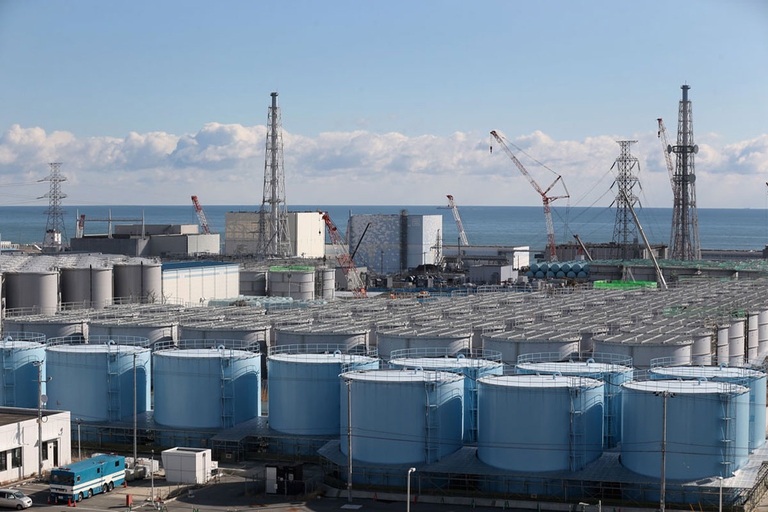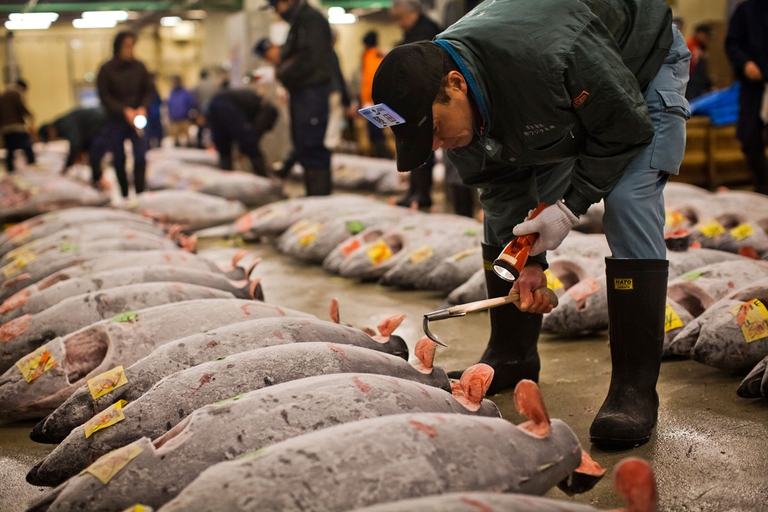
The decline in grey and humpback whales in the Pacific and Atlantic Oceans has been traced to food shortages caused by rising ocean temperatures.
A group of experts in Tokyo suggested pouring radioactive water from Fukushima into the open sea. A marine biochemist explains the consequences of this absurd decision.
Almost a decade after the Fukushima nuclear disaster, a solution is yet to be found for the disposal of the contaminated water from the power station that was hit by a tsunami on March 11th, 2011. A committee of experts from the Japanese Ministry of Industry recommended that the radioactive liquid be poured into the ocean and Japan’s former Environment Minister, Yoshiaki Harada, had already suggested this was the only possible solution in September 2019. Finally, on 13th April 2021, the Japanese government said it had officially decided to release over one million tonnes of treated radioactive water into the Pacific Ocean, starting in 2023.
Ken Buesseler is a marine biochemist at the Woods Hole Oceanographic Institution (WHOI), the largest independent oceanography research institute in the United States. Since 2011, this scientist and his team have periodically done on-site research at Fukushima. In an exclusive interview with LifeGate, Buesseler sheds light on issues related not only to disposal solutions but also to the plant’s storage system.
The water from the reactors goes through a decontamination system that has been officially active since 2013, before ending up in the storage tanks. To date, over a million tonnes of radioactive water have been treated. This water is kept in over 1,000 tanks, with a new one being filled each week. According to TEPCO (Tokyo Electric Power Company), the organisation that manages the Fukushima plant, the tanks’ maximum capacity is 1.37 million tonnes. This figure will be reached in 2022, after which point there will be no more space.
“They [TEPCO executives, ed.] claim they’re running out of storage space, which is another thing I think we can push back on,” says Buesseler. “From an aerial view, there is clearly land to build more, but maybe they have other plans for that space? However, the areas surrounding that site are off-limits for people to live and work there. This means they’re making a choice not to use space on land that’s currently not being used. I think they’ve kind of jumped ahead and said ‘we’re running out of space, therefore we have to dump'”.
The constant release of radionuclides from the tanks at Fukushima and from groundwater will have to be carefully evaluated because the character and combination of radionuclides are continuously changing. “The problem isn’t the presence of tritium [a radioactive hydrogen isotope, ed.] in the tanks so much as the presence of other radioactive isotopes. TEPCO made a website listing some of these contaminants – such as strontium 90, lithium, iodine 129 and others – that have been found in the tanks in quantities larger than those legally permitted for discharge. The water should be treated, but reading the data from the site, it’s not clear that this is happening,” Buesseler continues.
“For example, the amount of strontium 90 is 10,000 times higher in this individual tank group than what’s allowed to be released by law. I’ve checked and it’s not obvious to me from the website that they’ve even started to remove the other, more dangerous contaminants”.
However, Buesseler adds, there are possible alternatives for the disposal of contaminated water. One of these is based on the half-life of radioactive isotopes, which is the time it takes for half the initial mass of the radioactive chemical element to decay.
“Tritium has this 12-year half-life, meaning it decays 50% in 12 years. It’s already been eight years since the disaster, so there’s far less tritium now than in 2011,” Buesseler explains. “As an example, if you waited 60 years and built more tanks in the meantime, you would lose 97% of the tritium because of radioactive decay. The 60 years give you a 97% loss. It’s true that we won’t get rid of it completely, but we could definitely find a way to ensure significant reduction”.
In his statement, Minister Harada claimed that the radioactive waters would be diluted before being poured into the ocean. Would this process help to make the polluted water less damaging? “For tritium it helps a bit, but with things like strontium, lithium, and cobalt the total amount you release would still be the same, and it would accumulate in marine biota in the seafloor,” Buesseler explains.
“Tritium is basically a form of water, meaning it would move with the currents. But some of the other isotopes wouldn’t, so disposal would end up slowly increasing the concentrations locally, causing problems for the biosphere and for fisheries. The chemistry is different for each of these radionuclides, providing another reason why you’d want to monitor and adjust,” Buesseler goes on.
Even if radioactive water was disposed of in the ocean, currents would dictate where it goes. Dangerous isotopes would either accumulate on the seafloor, affecting the marine biota, or move primarily with the current.Ken Buesseler, WHOI
Each one of these contaminant isotopes behaves differently in the ocean, with respect to marine fauna as well. Strontium 90, for example, is problematic because it mimics the behaviour of calcium and would end up accumulating in the bones of fish. Tritium, on the other hand, passes quickly through fish, as if it were water. According to Buesseler, it would be advisable to activate an independent system for constant monitoring. In this case, this idea doesn’t yet seem to have been looked at.
“I believe that not only should we independently monitor each one of the storage tanks to understand what’s in there, but also the levels of radioactive isotopes in the ocean after they’re eventually disposed of. However, I’ve not heard anything about a monitoring programme of this kind, so the Minister’s statement seemed really rushed to me,” Buesseler asserts. “Obviously, storing water in an earthquake-prone area has its own caveats and risks, so there’s always a trade-off between risks from one thing or another”.
Can anything be done in terms of engineering? “The earliest tanks were bolted together rather than welded, and some of them were failing. Now they’ve switched to a newer welded tank design, but none of these things was designed for a 60-year lifetime. So the idea of storage would involve building larger, earthquake-proof tanks,” Buesseler explains.
Minister Harada’s statement in 2019 not only brought public attention back to issues relating to the Fukushima disaster, but also caused an outcry among fishing organisations. In recent years, fish prices on the market had returned to pre-2011 levels. “The good news for Japan is that, in the last four years, none of the seafood that’s being monitored has exceeded their very strict standards for radioactivity in seafood products. So they’re coming out of this period where fisheries and markets have been reopening,” Buesseler states.
Pouring the contaminated water into the sea would be a problem that affects other countries as well. South Korea, for example, has voiced its worries about the plan. The country has not yet revoked the ban introduced in 2013 to cease importing fish from Fukushima, and the government stated last week that the disposal of contaminated water in the ocean would represent a “serious threat” to marine wildlife. Officials from Japan’s fishing sector, however, have highlighted the fact that – based on rigorous testing – the sale of any seafood containing more than 50 becquerels of radioactive material per kilogram is strictly prohibited. This threshold is much lower compared with the 100-becquerel standard applied to the rest of Japan.
According to Buesseler, there doesn’t seem to be any real risk for South Korea. “Ocean currents don’t head in their direction. Even if radioactive water was disposed of in the ocean, currents would dictate where it goes. Dangerous isotopes would either accumulate on the seafloor, affecting the marine biota, or move primarily with the current. There’s a very strong current just south of Japan, the Kuroshio current, which reaches all the way to the Bering Strait. I like to call it the Gulf stream of the Pacific. It’s the reason why, in 2011, people on the West coast of the US were worried about Japanese radioactivity reaching them. This turned out to be measurable but in very, very low levels. South Korea and other Asian countries have very little to worry about”.
However, what we must keep in mind is that, in cases such as these, what matters is how consumers perceive the issue. Disposing of radioactive water in the ocean would short-circuit the region’s fishing sector. “There’s undoubtedly a public perception that any release, tritium included, would stop people from buying fish from that region,” Buesseler claims. “So, whether there’s a health risk or not, the perceived risk is certainly very real.”
Siamo anche su WhatsApp. Segui il canale ufficiale LifeGate per restare aggiornata, aggiornato sulle ultime notizie e sulle nostre attività.
![]()
Quest'opera è distribuita con Licenza Creative Commons Attribuzione - Non commerciale - Non opere derivate 4.0 Internazionale.
The decline in grey and humpback whales in the Pacific and Atlantic Oceans has been traced to food shortages caused by rising ocean temperatures.
The United Nations has launched a major international alliance for ocean science, undertaking a mission close to all our hearts.
The cargo ship that ran aground off the coast of Mauritius on 25 July, causing incalculable damage, has split in two and its captain has been arrested.
The largest coral reef in the world is severely threatened by climate change, but researchers are developing strategies that could contribute to saving the Great Barrier Reef.
Seychelles have extended its marine protected area, which now covers over 400,000 square kilometres, an area larger than Germany.
Norwegian oil giant Equinor had pulled out of drilling for oil in the Great Australian Bight, one of the country’s most uncontaminated areas. A victory for activists and surfers who are now campaigning for the area to be protected forever.
30 per cent of the planet needs to be protected to stop precipitous species decline. The UN has set out its aims for the the COP15 on biodiversity scheduled for Kunming, China in October.
Ocean warming has risen to record highs over the last five years: just in 2019 the heat released into the world’s oceans was equivalent to that of 5-6 atomic bombs per second. The culprit, no doubt, is climate change.
Refusing the anthropocentric vision and respecting the laws of ecology is the only way to safeguard the future of our and all other species, Sea Shepherd President Paul Watson argues in this op-ed.










